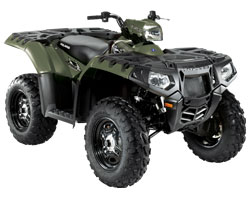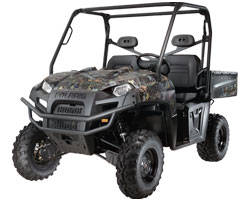The Idiot's Guide to Food Plots
If there was mistake to make, we made it. Here's how to turn planting your own food plot into a simple task.

The day my brother, Aaron, closed the deal on a 70-acre spread in eastern Connecticut was one of the happiest days of my life. Was I proud to see my little brother's years of hard work running his own business pay off in such an impressive fashion? Sure. Was I pumped that I had just scored a primo hunting spot an hour from my house without spending a nickel of my own cash? Baby, you know it's true!
The decision to put a food plot on the property was a no-brainer. For a housewarming gift, I got him a bag of seed. The land had mixed hardwoods spread over a series of granite ridges with wetlands in the bottoms. Not far from the center of the property was an overgrown four-acre pasture filled with an unruly tangle of grass and brush. Deer and turkey sign were everywhere. When Aaron sighted a mature 10-point piebald buck that first winter in the woods and then picked up a heavy shed from a whopper 8-pointer in early spring, our suspicions about the spot's potential were confirmed. Big bucks were in our future.
By this time I had already put the wheels in motion to create the food plot of our dreams, a buffet of clover, soybeans and chicory so lush that every whitetail in the state would queue up for a shot at it-all within view of our artfully placed tree stands. The land would be a trophy-buck magnet.
It would be almost too easy. Even though my brother and I didn't grow up on a farm, our parents had an obsessive need to cultivate. While other kids spent their summers lazing around at the beach, we toiled for hours in our gardens planting seeds, weeding, removing rocks and waging a never-ending war against the slugs that would defile our tomatoes, herbs, squash and strawberries. We were given all the ice water we could drink and, if we kept at it hard enough, an ice cream float in the afternoon. We were like underage sharecroppers with a sweet tooth. We hated it, but it gave us an education in the basics of horticulture.
We also had a leg up thanks to the two John Deere tractors my brother owned, which we used to clear the overgrowth in our food-plot-to-be. To fully gear up, I contacted some relevant companies. From Land Pride, we got a rotary tiller and do-it-all Plot Ranger. I ordered a sprayer from Great Day, enough herbicide from Roundup for the four acres and more seeds from Mossy Oak Biologic. A Yamaha Rhino utility vehicle, to pull our Plot Ranger and sprayer, completed the fleet. We were ready to farm.
STEP 1: Timing is Everything
Ready to farm, yes. But by the time we took delivery of all our stuff, it was well into summer. The spring growing season had passed us by. No matter. Most seed mixes can be effective whenever you plant them. To be sure, however, I put in a call to Bobby Cole at Mossy Oak Biologic.
"The seeds are fine, but have you tested your soil?" he asked. It hadn't occurred to us to do so.
"You know, if your soil chemistry is off, not only will the seeds not grow as well, but the deer won't find the forage nearly as palatable," he explained. So we did a quick soil test and got the results back within a few days. Turned out the soil was seriously potassium-deficient. Unfortunately, to correct the situation we would need to spread about 2,000 pounds of lime across the four acres. We had neither the time nor the money to fix this problem. The deer would have to be satisfied eating whatever popped up, regardless of its mineral content or, apparently, flavor.
STEP 2: Spray and Pray
We were now ready to kill off the grass and other shrubs with the Roundup. But as my brother prepared to assemble our sprayer and attach it to the Rhino, he realized I had ordered the wrong mounting bracket for the spray boom. We weren't about to wait around. Weeds or no weeds, we wanted to start tilling. I hooked up the Plot Ranger to the Rhino as Aaron attached the rotary tiller to his big John Deere. I twisted the key to put the Rhino in action and...nothing. The motor turned over, but the vehicle wouldn't start. The Yamaha had worked fine when we took delivery a few weeks prior, but after spending an hour poking and prodding the engine, I gave up.
My brother had no such problem. The rotary tiller chewed through the turf, leaving fresh-turned soil in its wake. The only drawback was the rocks. Lots and lots of rocks. Of course, this shouldn't have come as a surprise, given that stout granite walls surrounded the field and crisscrossed his property. Even so, the rocks caught us off guard. No matter how gingerly my brother dipped the blades of the tiller into the ground, we cringed at the sound of stone grating against metal. Our progress was glacial. Then came a noise from the tiller unlike any we had heard, a pounding ka-THUNK, ka-THUNK, ka-THUNK. "Um, I don't think it's supposed to do that," I said.
A look under the rear flap of the tiller showed the spindle attached on only one side. The bolts connecting the rotor to the drive gear, which we later learned weren't tightened properly, had been sheared off.
Desperate to get some tilling done, I hitched the do-it-all Plot Ranger, which has disks to turn the soil and a seed broadcaster and tamper for planting, to my brother's smaller tractor. I know these units work-I have friends who swear by them and I've even seen them in action. But as I pulled the Plot Ranger around the field, not only was it not cutting through the turf, but I couldn't even see a mark on the grass to indicate it had passed. The ground was too hard and the disks just bounced along on top of the turf. Whenever I turned the tractor, though, I could make out indentations where the disks were trying to cut. I took this as an encouraging sign and started to drive in a circle. After a few minutes I could see a faint outline on the grass. Progress! After a few more minutes, I saw my brother waving his arms at me in alarm. I stopped the tractor.
"What's wrong?" "I thought the steering on the tractor was broken and you couldn't stop." "Broken? Are you kidding? I figured it out. Look at the ground!" He stared down at the field to where I was pointing at the mangled grass. "It didn't even cut through to the dirt," he said. He was right. Driving in circles had been for naught. I went to grab the remote control to raise the disks so I could pull the unit back into the barn. I found the cord for the controller trailing behind the machine, neatly sliced in two.
STEP 3: Rock and Roll
While we waited to get the Rhino fixed (faulty fuel pump), the tiller replaced and the new mounting bracket for the sprayer, Aaron spent hour after hour picking rocks out of the ground with his tractor, using the backhoe on one end and the grapple claw on the other. Soon hundreds of rocks, some as small as soccer balls, others as large as washing machines, formed a pile along one edge of the field.
Summer was passing us by, and so was our window to get seed into the ground before hunting season. Deer still came into the field to eat grass, but after we sprayed the Roundup and killed a bunch of it, we saw their sign less often.
By the beginning of bow season, my deer-hunting Garden of Eden was nothing more than a pitted plot of barren earth. The surface of Mars would have been more inviting.
Come October, the equipment was back in working order, but whatever growing season remained could be measured in hours, not days. My busy schedule kept me on the road, hunting mostly out of state-caribou in Canada, elk in New Mexico, our annual deer camp in Michigan. One of my brother's friends killed a doe on the property, but that was it. So we're looking forward to this spring. The deer are still there, and right about as you read this we'll be putting in an amazing food plot. You can count on it: It's a no-brainer.
STEP BY STEP
- Collect bits of dirt from different parts of your plot to get a full report on the soil's chemistry, including suggestions on which seed mixes to use. ($7.50; mossyoakbiologic.com)
- Great Day's Plot Pro sprayer made killing grass simple. It holds 25 gallons and attached easily to our utility vehicle. ($293; greatday inc.com)
- For precise spraying control, the sprayer comes with a push-button remote you can use while driving.
- Land Pride's RTA25 rotary tiller is tough as nails. And given the number of rocks in our field, it needed to be. The trick to good tilling is not to push the tines too deep, just a couple of inches into the soil. ($3,956; landpride.com)
- Land Pride's Plot Ranger takes care of the planting with its seed spreader and tamper ($2,515; landpride.com)
- Rocks and more rocks. We pulled hundreds out of the field.
- One of the bucks roaming our land beat up this 3-D archery target.
IDIOT MISTAKE #1
Hard, rocky ground will not cut or till without help from a powered rotary tiller or a deep-biting plow. Talk to some farmers in your area to see what they recommend as a minimum for gear to cultivate your plot.
IDIOT MISTAKE #2
Make sure you don't let the control cords for your equipment trail behind the tractor. Trust us, no good will come of this.
IDIOT MISTAKE #3
You need only a tiny amount of seed-to-soil contact to get your forage to grow. If you bury your seeds too deep, they won't germinate well.
ADVERTISEMENT
Related Vehicles
The Polaris Sportsman® 850 XP
Sportsman XP Facts:
- 850 SOHC Twin EFI Engine
- Available Electronic Power Steering
- Legendary Smooth Rolled Independent Rear Suspension (IRS)
- Superior Ergonomics
Learn More about the Sportsman XP >>
The Polaris RANGER 800 XP®
Ranger 800 XP Facts:
- New! 800 Twin EFI Engine
- Available Electric Power Steering
- Dual A-Arm Front Suspension
- Legendary Smooth Independent Rear Suspension (IRS)
Deer Management Archive
Deer Population by State
Weekly QDM Tips
Take a camera survey of your herd in the pre-season. Mount trail cameras near high-traffic deer areas such as mineral licks, food plots, or fence crossings. Record the number, sex and approximate age of every deer you “shoot”, then compare that data with your field observations come hunting season.







